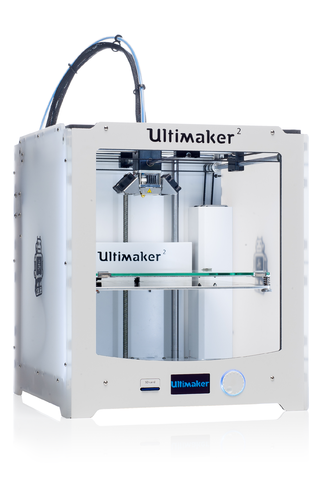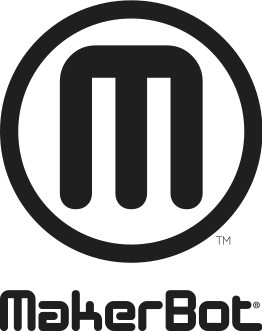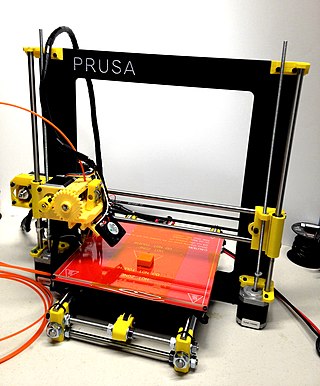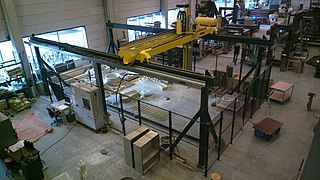
3D printing or additive manufacturing is the construction of a three-dimensional object from a CAD model or a digital 3D model. It can be done in a variety of processes in which material is deposited, joined or solidified under computer control, with the material being added together, typically layer by layer.

Stratasys, Ltd. is an American-Israeli manufacturer of 3D printers, software, and materials for polymer additive manufacturing as well as 3D-printed parts on-demand. The company is incorporated in Israel. Engineers use Stratasys systems to model complex geometries in a wide range of polymer materials, including: ABS, polyphenylsulfone (PPSF), polycarbonate (PC) and polyetherimide and Nylon 12.

MakerBot Industries, LLC was an American desktop 3D printer manufacturer company headquartered in New York City. It was founded in January 2009 by Bre Pettis, Adam Mayer, and Zach "Hoeken" Smith to build on the early progress of the RepRap Project. It was acquired by Stratasys in June 2013. As of April 2016, MakerBot had sold over 100,000 desktop 3D printers worldwide. Between 2009 and 2019, the company released 7 generations of 3D printers, ending with the METHOD and METHOD X. It was at one point the leader of the desktop market with an important presence in the media, but its market share declined over the late 2010s. MakerBot also founded and operated Thingiverse, the largest online 3D printing community and file repository. In August 2022, the company completed a merger with its long-time competitor Ultimaker. The combined company is known as UltiMaker, but retains the MakerBot name for its Sketch line of education-focused 3D printers.
D-Shape is a large 3-dimensional printer that uses binder-jetting, a layer by layer printing process, to bind sand with an inorganic seawater and magnesium-based binder in order to create stone-like objects. Invented by Enrico Dini, founder of Monolite UK Ltd, the first model of the D-Shape printer used epoxy resin, commonly used as an adhesive in the construction of skis, cars, and airplanes, as a binder. Dini patented this model in 2006. After experiencing problems with the epoxy, Dini changed the binder to the current magnesium-based one and patented the printer again in September 2008. In the future, Dini aims to use the printer to create full-scale buildings.
Printrbot is a 3D printer company created by Brook Drumm in 2011 and originally funded through Kickstarter. Printrbot printers use fused deposition modelling to manufacture 3-dimensional artifacts.

Fab@Home is a multi-material 3D printer, launched in 2006. It was one of the first two open-source DIY 3D printers in the world, at a time when all other additive manufacturing machines were still proprietary. The Fab@Home and the RepRap are credited with sparking the consumer 3D printing revolution.
Construction 3D Printing (c3Dp) or 3D construction Printing (3DCP) refers to various technologies that use 3D printing as a core method to fabricate buildings or construction components. Alternative terms for this process include "additive construction." "3D Concrete" refers to concrete extrusion technologies whereas Autonomous Robotic Construction System (ARCS), large-scale additive manufacturing (LSAM), or freeform construction (FC) refer to other sub-groups.

Solidoodle was a 3D printer company headquartered in Brooklyn, New York. Solidoodle was founded in September 2011 by engineer Sam Cervantes. Solidoodle 3D printers use digital files supplied by the user to create physical plastic parts.
A recyclebot is an open-source hardware device for converting waste plastic into filament for open-source 3D printers like the RepRap. Making DIY 3D printer filament at home is both less costly and better for the environment than purchasing conventional 3D printer filament. In following the RepRap tradition there are recyclebot designs that use mostly 3-D printable parts.

Airwolf 3D is a company related to 3D printers.
Zortrax is a Polish manufacturer of 3D printers and filaments for SMB market and rapid prototyping for industries, including robotics and automation, architecture, industrial design, engineering, aviation, industrial automation. Zortrax machines work with dedicated software, firmware and filaments.

Fused filament fabrication (FFF), also known as fused deposition modeling, or filament freeform fabrication, is a 3D printing process that uses a continuous filament of a thermoplastic material. Filament is fed from a large spool through a moving, heated printer extruder head, and is deposited on the growing work. The print head is moved under computer control to define the printed shape. Usually the head moves in two dimensions to deposit one horizontal plane, or layer, at a time; the work or the print head is then moved vertically by a small amount to begin a new layer. The speed of the extruder head may also be controlled to stop and start deposition and form an interrupted plane without stringing or dribbling between sections. "Fused filament fabrication" was coined by the members of the RepRap project to give an acronym (FFF) that would be legally unconstrained in its use.

The Prusa i3 is a family of fused deposition modeling 3D printers, manufactured by Czech company Prusa Research under the trademarked name Original Prusa i3. Part of the RepRap project, Prusa i3 printers were called the most used 3D printer in the world in 2016. The first Prusa i3 was designed by Josef Průša in 2012, and was released as a commercial kit product in 2015. The latest model is available in both kit and factory assembled versions. The Prusa i3's comparable low cost and ease of construction and modification made it popular in education and with hobbyists and professionals, with the Prusa i3 model MK2 printer receiving several awards in 2016.

A variety of processes, equipment, and materials are used in the production of a three-dimensional object via additive manufacturing. 3D printing is also known as additive manufacturing, because the numerous available 3D printing process tend to be additive in nature, with a few key differences in the technologies and the materials used in this process.

Hangprinter is an open-source fused deposition modeling delta 3D printer notable for its unique frameless design. It was created by Torbjørn Ludvigsen. The Hangprinter uses relatively low cost parts and can be constructed for around US$250. The printer is part of the RepRap project, meaning many of the parts of the printer are able to be produced on the printer itself. The design files for the printer are available on GitHub for download, modification and redistribution.

3D printing filament is the thermoplastic feedstock for fused deposition modeling 3D printers. There are many types of filament available with different properties.
Liquid additive manufacturing (LAM) is an additive manufacturing technique which deposits a liquid or high viscosity material (e.g Liquid Silicone Rubber) onto a build surface to create an object which then vulcanised using heat to harden the object. The process was originally created by Adrian Bowyer and was then built upon by the company German RepRap.
3D printing speed measures the amount of manufactured material over a given time period, where the unit of time is measured in Seconds, and the unit of manufactured material is typically measured in units of either kg, mm or cm3, depending on the type of additive manufacturing technique.

3D concrete printing, or simply concrete printing, refers to digital fabrication processes for cementitious materials based on one of several different 3D printing technologies. 3D printed concrete eliminates the need for formwork, reducing material waste and allowing for greater geometric freedom in complex structures. With recent developments in mix design and 3D printing technology over the last decade, 3D concrete printing has grown exponentially since its emergence in the 1990s. Architectural and structural applications of 3D-printed concrete include the production of building blocks, building modules, street furniture, pedestrian bridges, and low-rise residential structures.











